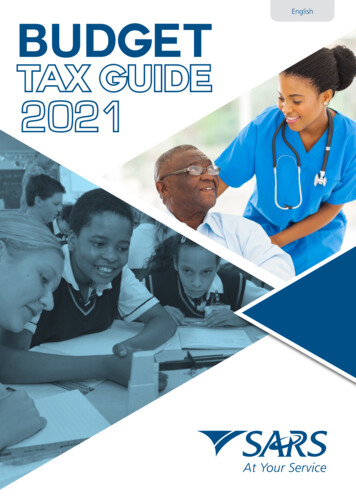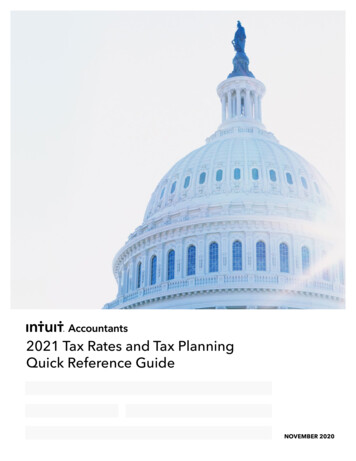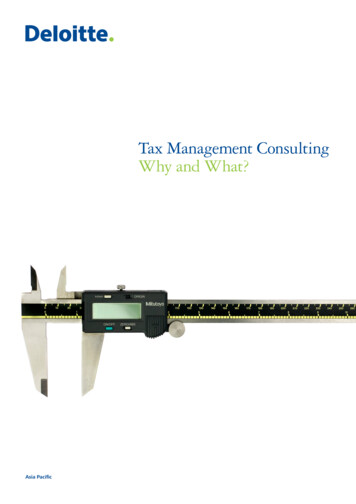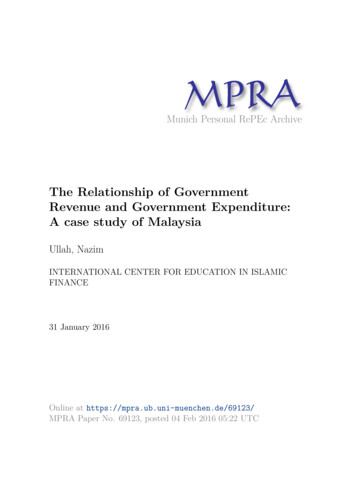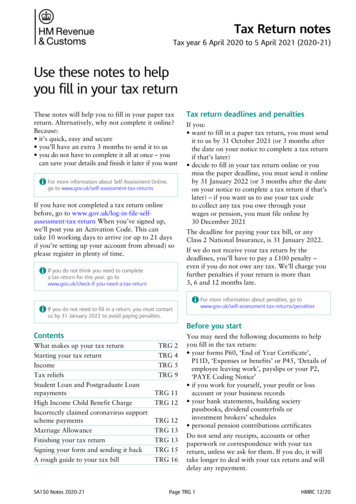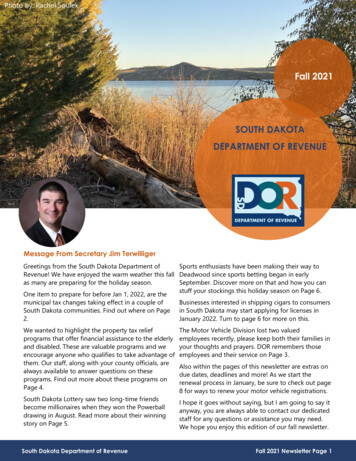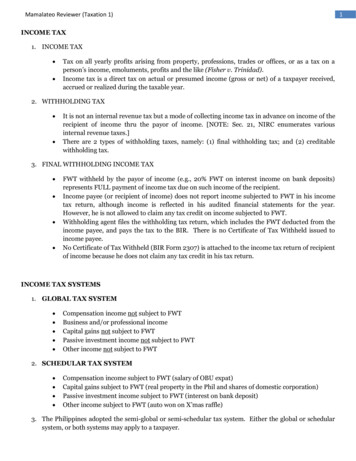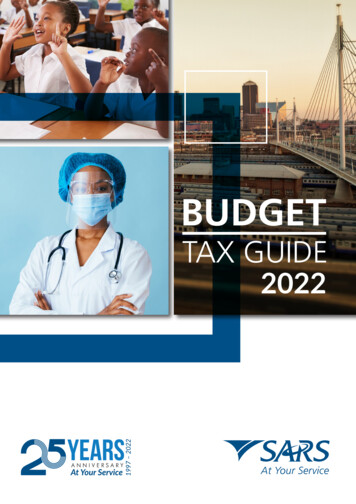
Transcription
1BUDGETTAX GUIDE2022
1This SARS tax pocket guide provides a synopsis of the mostimportant tax, duty and levy related information for 2022/23.INCOME TAX: INDIVIDUALS AND TRUSTSTax rates from 1 March 2022 to 28 February 2023:Individuals and special trustsTaxable Income (R)Rate of Tax (R)1 – 226 00018% of taxable income226 001 – 353 10040 680 26% of taxable income above 226 000353 101 – 488 70073 726 31% of taxable income above 353 100488 701 – 641 400115 762 36% of taxable income above 488 700641 401 – 817 600170 734 39% of taxable income above 641 400817 601 – 1 731 600239 452 41% of taxable income above 817 6001 731 601 and above614 192 45% of taxable income above 1 731 600Trusts other than special trusts: rate of tax 45%RebatesPrimary R16 425Secondary (Persons 65 and older) R9 000Tertiary (Persons 75 and older)R2 997Age Tax ThresholdBelow age 65 R91 250Age 65 to below 75R141 250Age 75 and overR157 900
2Provisional TaxA provisional taxpayer is any person who earns income by wayof remuneration from an unregistered employer, or income thatis not remuneration, or an allowance or advance payable by theperson’s principal. An individual is not required to pay provisionaltax if he or she does not carry on any business, and the individual'staxable income: Will not exceed the tax threshold for the tax year; or from interest, dividends, foreign dividends, rental from theletting of fixed property, and remuneration from an unregisteredemployer will be R30 000 or less for the tax year.Provisional tax returns showing an estimation of total taxableincome for the year of assessment are required from provisionaltaxpayers.Deceased estates are not provisional taxpayers.Retirement fund lump sum withdrawal benefitsTaxable income (R)Rate of tax (R)1 – 25 0000% of taxable income25 001 - 660 00018% of taxable income above 25 000660 001 - 990 000114 300 27% of taxable income above 660 000990 001 and above203 400 36% of taxable income above 990 000Retirement fund lump sum withdrawal benefits consist of lumpsums from a pension, pension preservation, provident, providentpreservation or retirement annuity fund on withdrawal (includingassignment in terms of a divorce order).
3Tax on a specific retirement fund lump sum withdrawal benefit(lump sum X) is equal to: The tax determined by the application of the tax table tothe aggregate of lump sum X, plus all other retirement fundlump sum withdrawal benefits accruing from March 2009, allretirement fund lump sum benefits accruing from October2007, and all severance benefits accruing from March 2011;less the tax determined by the application of the tax table to theaggregate of all retirement fund lump sum withdrawal benefitsaccruing before lump sum X from March 2009, all retirementfund lump sum benefits accruing from October 2007, and allseverance benefits accruing from March 2011.Retirement fund lump sum benefits or severance benefitsTaxable income (R)Rate of tax (R)1 – 500 0000% of taxable income500 001 - 700 00018% of taxable income above 500 000700 001 – 1 050 00036 000 27% of taxable income above 700 0001 050 001 and above130 500 36% of taxable income above 1 050 000Retirement fund lump sum benefits consist of lump sums from apension, pension preservation, provident, provident preservationor retirement annuity fund on death, retirement or terminationof employment due to attaining the age of 55 years, sickness,accident, injury, incapacity, redundancy or termination of theemployer’s trade.Severance benefits consist of lump sums from or by arrangementwith an employer due to relinquishment, termination, loss,repudiation, cancellation or variation of a person’s office oremployment.
4Tax on a specific retirement fund lump sum benefit or a severancebenefit (lump sum or severance benefit Y) is equal to: The tax determined by the application of the tax table to theaggregate of amount Y plus all other retirement fund lump sumbenefits accruing from October 2007 and all retirement fundlump sum withdrawal benefits accruing from March 2009 and allother severance benefits accruing from March 2011; less the tax determined by the application of the tax table to theaggregate of all retirement fund lump sum benefits accruingbefore lump sum Y from October 2007 and all retirement fundlump sum withdrawal benefits accruing from March 2009 andall severance benefits accruing before severance benefit Y fromMarch 2011.Dividends Dividends received by individuals from South African companiesare generally exempt from income tax, but dividends tax, at arate of 20%, is withheld by the entities paying the dividends tothe individuals. Dividends received by South African residentindividuals from REITs (listed and regulated property owningcompanies) are subject to income tax, and non-residents inreceipt of those dividends are only subject to dividends tax.Foreign Dividends Most foreign dividends received by individuals from foreigncompanies (shareholding of less than 10% in the foreign company)are taxable at a maximum effective rate of 20%. No deductionsare allowed for expenditure to produce foreign dividends.Interest exemptions Interest from a South African source, earned by any naturalperson under 65 years of age, up to R23 800 per annum, andpersons 65 and older, up to R34 500 per annum, is exempt fromincome tax.
5 Interest earned by non-residents, who are physically absent fromSouth Africa for at least 182 days during the 12 month period,before the interest accrues and the interest bearing debt is noteffectively connected to a fixed place of business in South Africa,is exempt from income tax.DeductionsRetirement fund contributions Amounts contributed to pension, provident and retirementannuity funds during a year of assessment are deductible bymembers of those funds. Amounts contributed by employersand taxed as fringe benefits are treated as contributions bythe individual employees. The deduction is limited to 27.5% ofthe greater of the amount of remuneration for PAYE purposesor taxable income (both excluding retirement fund lump sumsand severance benefits). The deduction is further limited tothe lower of R350 000 or 27.5% of taxable income before theinclusion of a taxable capital gain. Any contributions exceedingthe limitations are carried forward to the immediately followingyear of assessment and are deemed to be contributed in thatfollowing year. The amounts carried forward are reduced bycontributions set off against retirement fund lump sums andretirement annuities.Medical and disability expensesIn determining tax payable, individuals are allowed to deduct: Monthly contributions to medical schemes (a tax rebate referredto as a medical scheme fees tax credit) by the individual who paidthe contributions up to R347 for each of the first two personscovered by those medical schemes, and R234 for each additionaldependant; and
6 in the case of:» an individual who is 65 years and older, or if an individual, hisor her spouse, or his or her child is a person with a disability,33.3% of the sum of qualifying medical expenses paid and borneby the individual, and an amount by which medical schemecontributions paid by the individual exceed three times themedical scheme fees tax credits for the tax year; or» any other individual, 25% of an amount equal to the sum of thequalifying medical expenses paid and borne by the individual,and an amount by which medical scheme contributions paid bythe individual exceed four times the medical scheme fees taxcredits for the tax year, limited to the amount which exceeds7.5% of taxable income (excluding retirement fund lump sumsand severance benefits).Donations Deductions in respect of donations to certain public benefitorganisations are limited to 10% of taxable income (excludingretirement fund lump sums and severance benefits). The amountof donations exceeding 10% of the taxable income is treatedas a donation to qualifying public benefit organisations in thefollowing tax year.AllowancesSubsistence allowances and advancesWhere the recipient is obliged to spend at least one night awayfrom his or her usual place of residence on business, and theaccommodation to which that allowance or advance relates isin the Republic of South Africa, and the allowance or advance isgranted to pay for meals and incidental costs or incidental costsonly, an amount, published on the SARS website www.sars.gov.za,under Legal Counsel / Secondary Legislation / Income Tax Notices /Determination of the daily amount in respect of meals and incidentalcosts, is deemed to have been expended per day.
7Where the accommodation to which that allowance or advancerelates is outside the Republic of South Africa, a specific amountper country is deemed to have been expended. Details of theseamounts are published on the SARS website www.sars.gov.za,under Legal Counsel / Secondary Legislation / Income Tax Notices/ Determination of the daily amount in respect of meals andincidental costs.Where the recipient is by reason of the duties of his or her office oremployment obliged to spend a part of a day away from his or herusual place of work or employment, a reimbursement or advancefor expenditure actually incurred by the recipient is exempt if therecipient is allowed by his or her principal to incur expenditureon meals and other incidental costs for that part of a day and theamount of the expenditure does not exceed an amount publishedon the SARS website www.sars.gov.za, under Legal Counsel /Secondary Legislation / Income Tax Notices / Determination of thedaily amount in respect of meals and incidental costs.Travelling allowanceRates per kilometre, which may be used in determining theallowable deduction for business travel against an allowance oradvance where actual costs are not claimed, are determined usingthe table published on the SARS website www.sars.gov.za, underLegal Counsel / Secondary Legislation / Income Tax Notices / Fixingof rate per kilometre in respect of motor vehicles.Note: 80% of the travelling allowance must be included in theemployee’s remuneration for the purposes of calculating PAYE.The percentage is reduced to 20% if the employer is satisfiedthat at least 80% of the use of the motor vehicle for the tax yearwill be for business purposes.
8 No fuel cost may be claimed if the employee has not borne the fullcost of fuel used in the vehicle, and no maintenance cost may beclaimed if the employee has not borne the full cost of maintainingthe vehicle (e.g. if the vehicle is covered by a maintenance plan). The fixed cost must be reduced on a pro-rata basis if the vehicleis used for business purposes for less than a full year. The actual distance travelled during a tax year, and the distancetravelled for business purposes substantiated by a log book, areused to determine the costs which may be claimed against atravelling allowance.Alternatively:Where an allowance or advance is based on the actual distancetravelled by the employee for business purposes, no tax is payableon an allowance paid by an employer to an employee, up to therate published on the SARS website www.sars.gov.za, under LegalCounsel / Secondary Legislation / Income Tax Notices / Fixing ofrate per kilometre in respect of motor vehicles, regardless of thevalue of the vehicle.However, this alternative is not available if other compensation inthe form of an allowance or reimbursement (other than for parkingor toll fees) is received from the employer in respect of the vehicle.Other deductionsOther than the deductions set out above, an individual may onlyclaim deductions against employment income or allowances inlimited specified situations, e.g. bad debt in respect of salary.
9Fringe BenefitsEmployer-owned vehicles The taxable value is 3.5% of the determined value (the cash costincluding VAT) of each vehicle per month. Where the vehicle is: the subject of a maintenance plan when the employer acquiredthe vehicle the taxable value is 3,25% of the determinedvalue; or acquired by the employer under an operating lease, thetaxable value is the cost incurred by the employer under theoperating lease plus the cost of fuel. 80% of the fringe benefit must be included in the employee’sremuneration for the purposes of calculating PAYE. Thepercentage is reduced to 20% if the employer is satisfied thatat least 80% of the use of the motor vehicle for the tax year willbe for business purposes. On assessment, the fringe benefit for the tax year is reducedby the ratio of the distance travelled for business purposes,substantiated by a log book, divided by the actual distancetravelled during the tax year. On assessment further relief is available for the cost of licence,insurance, maintenance and fuel for private travel, if the fullcost thereof has been borne by the employee and if the distancetravelled for private purposes is substantiated by a log book.Interest-free or low-interest loans The difference between interest charged at the official rate,and the actual amount of interest charged, is to be included ingross income.
10Residential accommodation The value of the fringe benefit to be included in gross incomeis the lower of the benefit calculated by applying a prescribedformula, or the cost to the employer if the employer does nothave full ownership of the accommodation. The formula will apply if the accommodation is owned by theemployee, but it does not apply to holiday accommodationhired by the employer from non-associated institutions.INCOME TAX: COMPANIESYears of assessment ending on any date between 1 April 2022 and30 March 2023.TypeRate of Tax (R)Companies28% of taxable incomeYears of assessment ending on any date on or after 31 March2023.TypeRate of Tax (R)Companies27% of taxable incomeINCOME TAX: SMALL BUSINESS CORPORATIONSYears of assessment ending on any date between 1 April 2022 and30 March 2023.Taxable Income (R)Rate of Tax (R)1 – 91 2500% of taxable income91 251 – 365 0007% of taxable income above 91 250365 001 – 550 00019 163 21% of taxable income above 365 000550 001 and above58 013 28% of the amount above 550 000
11Years of assessment ending on or after 31 March 2023.Taxable Income (R)Rate of Tax (R)1 – 91 2500% of taxable income91 251 – 365 0007% of taxable income above 91 250365 001 – 550 00019 163 21% of taxable income above 365 000550 001 and above58 013 27% of the amount above 550 000TURNOVER TAX FOR MICRO BUSINESSESYears of assessment ending on any date between 1 March 2022and 28 February 2023.Taxable turnover (R)Rate of tax (R)1 – 335 0000% of taxable turnover335 001 – 500 0001% of taxable turnover above 335 000500 001 – 750 0001 650 2% of taxable turnover above 500 000750 001 and above6 650 3% of taxable turnover above 750 000RESIDENCE BASIS OF TAXATION Residents are taxed on their worldwide income, subject tocertain exclusions. The general principle is that foreign taxeson foreign sourced income are allowed as a credit against SouthAfrican tax payable. This is applicable to individuals, companies,close corporations, trusts and estates.TAXATION OF CAPITAL GAINSCapital gains on the disposal of assets are included in taxableincome.
12Maximum effective rate of tax:Individuals and special trusts18%Companies 22.4% (will reduce to21.6%)Other trusts36%Events that trigger a disposal include a sale, donation, exchange,loss, death and emigration. The following are some of the specificexclusions: R2 million gain or loss on the disposal of a primary residence most personal use assets retirement benefits payments in respect of original long-term insurance policies annual exclusion of R40 000 capital gain, or capital loss is grantedto individuals and special trusts small business exclusion of capital gains of R1.8 million forindividuals (at least 55 years of age), when a small business witha market value not exceeding R10 million is disposed of instead of the annual exclusion, the exclusion granted toindividuals is R300 000 for the year of death.DIVIDENDS TAX Dividends tax is a final tax on dividends at a rate of 20%, paidby resident companies and non-resident companies in respect ofshares listed on the JSE or other South African licensed exchange.Dividends are tax exempt if the beneficial owner of the dividendis a South African company, retirement fund or other exemptperson. Non-resident beneficial owners of dividends may benefitfrom reduced tax rates in limited circumstances. The tax is tobe withheld by companies paying the taxable dividends, or byregulated intermediaries in the case of dividends on listed shares.The tax on dividends in kind (other than in cash) is payable, and isborne by the company that declares and pays the dividend.
13OTHER WITHHOLDING TAXESIn limited circumstances, the applicable tax rate may be reducedin terms of a tax treaty with the country of residence of a nonresident.Royalties A final tax, at a rate of 15%, is imposed on the gross amount ofroyalties from a South African source payable to non-residents.Interest A final tax, at a rate of 15%, is imposed on interest from a SouthAfrican source, payable to non-residents. Interest is exempt ifpayable by any sphere of the South African government, a bank,or if the debt is listed on a recognised exchange.Foreign entertainers and sportspersons A final tax, at the rate of 15%, is imposed on gross amountspayable to non-residents, for activities exercised by them inSouth Africa as entertainers or sportspersons.Disposal of immovable property A provisional tax is withheld on behalf of non-resident sellersof immovable property in South Africa, to be set off against thenormal tax liability of the non-residents. The tax to be withheldfrom payments to the non-residents is at a rate of 7.5% for a nonresident individual, 10% for a non-resident company, and 15%for a non-resident trust that is selling the immovable property.OTHER TAXES DUTIES AND LEVIESValue-added Tax (VAT)VAT is levied at the standard rate of 15% on the supply of goodsand services by registered vendors.
14A vendor making taxable supplies of more than R1 million perannum must register for VAT. A vendor making taxable supplies ofmore than R50 000, but not more than R1 million per annum, mayapply for voluntary registration. Certain supplies are subject to azero rate or are exempt from VAT.Transfer DutyTransfer duty is payable at the following rates on transactionswhich are not subject to VAT:Acquisition of property by all persons:Value of property (R)Rate1 – 1 000 0000%1 000 001 – 1 375 0003% of the value above R1 000 0001 375 001 – 1 925 000R11 250 6% of the value above R 1 375 0001 925 001 – 2 475 000R44 250 8% of the value above R 1 925 0002 475 001 – 11 000 000 R88 250 11% of the value above R2 475 00011 000 001 and aboveR1 026 000 13% of the value exceeding R11 000 000Estate Duty Estate duty is levied on the property of residents and the SouthAfrican property of non-residents less allowable deductions.The duty is levied on the dutiable value of an estate, at a rate of20%, on the first R30 million, and at a rate of 25% above R 3 0million. A basic deduction of R3.5 million is allowed in the determinationof an estate’s liability for estate duty, as well as deductions forliabilities, bequests to public benefit organisations, and propertyaccruing to surviving spouses.
15Donations Tax Donations tax is levied at a flat rate of 20% on the cumulativevalue of property donated since 1 March 2018 not exceedingR30 million, and at a rate of 25% on the cumulative value ofproperty donated since 1 March 2018 exceeding R30 million. The first R100 000 of property donated in each year by a naturalperson is exempt from donations tax. In the case of a taxpayer who is not a natural person, the exemptdonations are limited to casual gifts not exceeding R10 000 perannum in total. Dispositions between spouses, South African group companiesand donations to certain public benefit organisations, are exemptfrom donations tax.Securities Transfer Tax The tax is imposed at a rate of 0.25 % on the transfer of listed orunlisted securities. Securities consist of shares in companies ormember’s interests in close corporations.Tax on International Air Travel R190 per passenger departing on international flights, excludingflights to Botswana, Lesotho, Namibia and eSwatini, in whichcase the tax is R100.Skills Development LevyA skills development levy is payable by employers at a rate of 1%of the total remuneration paid to employees. Employers payingannual remuneration of less than R500 000 are exempt from thepayment of Skills Development Levies.
16Unemployment Insurance Contributions Unemployment insurance contributions are payable monthly byemployers, on the basis of a contribution of 1% by employers and1% by employees, based on the employees’ remuneration belowa certain amount. Employers not registered for PAYE or SDL must pay thecontributions to the Unemployment Insurance Commissioner.SARS INTEREST RATESRate of interest (from 1 February 2022)RateFringe benefits - interest-free or low-interest loan (official rate)5% p.a.Rates of interest (from 1 March 2022)RateLate or underpayment of tax7.25% p.a.Refund of overpayment of provisional tax3.25% p.a.Refund of tax on successful appeal or where the appeal was 7.25% p.a.conceded by SARSRefund of VAT after prescribed period7.25% p.a.Late payment of VAT7.25% p.a.Customs and Excise7.25% p.a.
HighlightsGranting tax relief by adjustingpersonal income tax bracketsand rebates for the effect ofinflationReduction in company incometax rate to 27 per cent for taxyears ending on or after31 March 2023Increases of between 4.5 and 6.5 percent in excise duties on alcohol andtobaccoNo changes to the general fuel levyand road accident fund levyIncreasing the monthlybenefits for employersunder the employmenttax incentive by50 per centHealth promotion levy onbeverages is increased by 0.1cent to 2.31 cents per gram ofsugar from 1 April 2022Plastic bag levy is increased by 3cents to 28 cents per bag from1 April 2022
This SARS tax pocket guide provides a synopsis of the most important tax, duty and levy related information for 2022/23. INCOME TAX: INDIVIDUALS AND TRUSTS Tax rates from 1 March 2022 to 28 February 2023: Individuals and special trusts Taxable Income (R) Rate of Tax (R) 1 - 226 000 18% of taxable income

